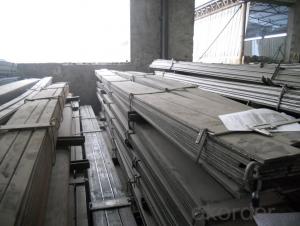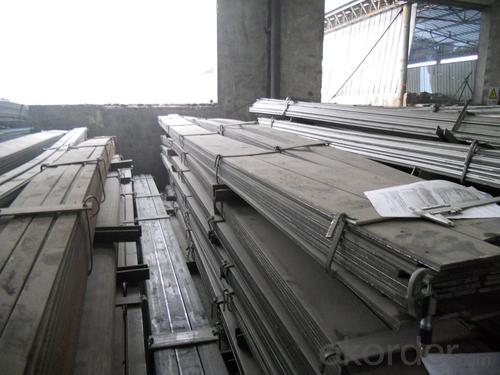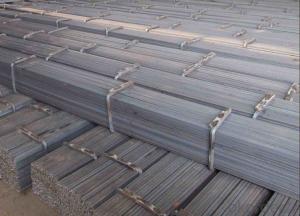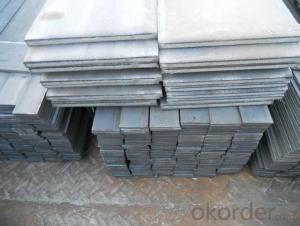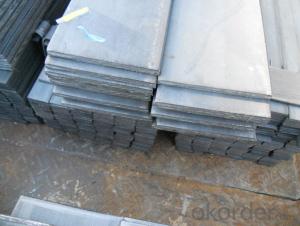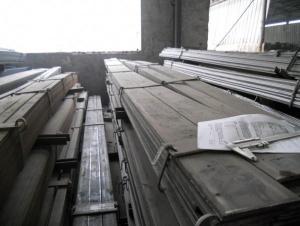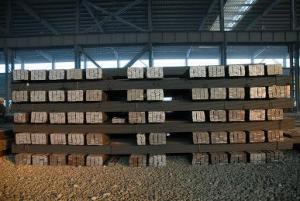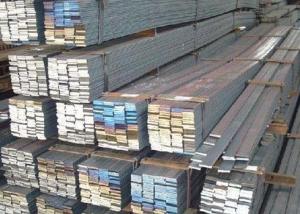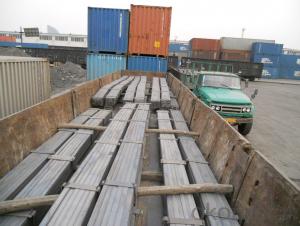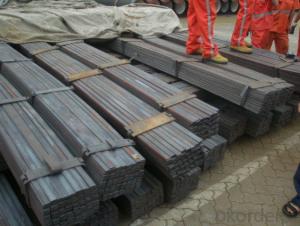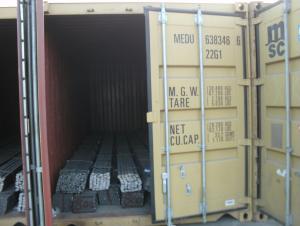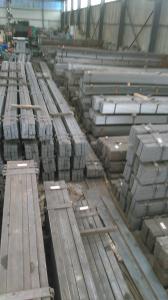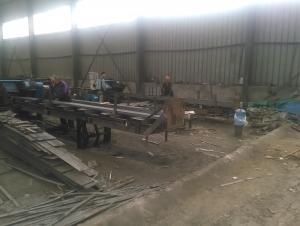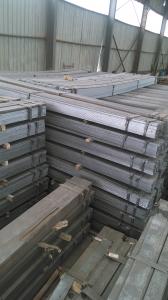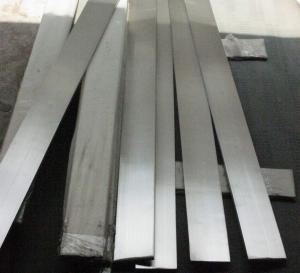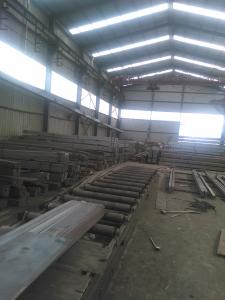HOT ROLLED FLAT BAR
- Loading Port:
- China Main Port
- Payment Terms:
- TT OR LC
- Min Order Qty:
- -
- Supply Capability:
- -
OKorder Service Pledge
OKorder Financial Service
You Might Also Like
Specifications of MS Channel:
1.We supply high quality MS Channel at reasonable price, including Chinese standard, Japanese standard and so on.
Standard | GB/JIS |
Material Grade | Q235,SS400 |
Technique: | Hot Rolled |
Sizes as per chinese standard: | 50*37*4.5mm - 300*89*11.5mm |
Sizes as per japanese standard: | 50*25*3mm – 200*80*7.5mm |
Length: | 6meter, 9meter, 12meter |
Note: 1.we are also competent to provide our customers other MS Channel based on other sizes according to customer’s requirements.
2. The length of our ms channel could be cut into other meters as per customer’s requirements. For example, the channel in 6meters could be cut into 5.8meters in order to be fit in the 20ft container.
2. The detailed sections of MS Channel as per GB standard.are shown in the table-1:
GB U CHANNEL | Standard | Sectional | Dimension |
| Mass: |
| (mm) | (mm) | (mm) | (mm) |
|
50X37 | 50 | 37 | 4.50 | 7.0 | 5.438 |
63X40 | 63 | 40 | 4.80 | 7.5 | 6.634 |
80x43 | 80 | 43 | 5.00 | 8.0 | 8.045 |
|
|
|
|
|
|
100x48 | 100 | 48 | 5.30 | 8.5 | 10.007 |
120x53 | 120 | 53 | 5.50 | 9.0 | 12.059 |
140x58 | 140 | 58 | 6.00 | 9.5 | 14.535 |
140x60 | 140 | 60 | 8.00 | 9.5 | 16.733 |
|
|
|
|
|
|
160x63 | 160 | 63 | 6.50 | 10.0 | 17.240 |
160x65 | 160 | 65 | 8.50 | 10.0 | 19.752 |
|
|
|
|
|
|
180x68 | 180 | 68 | 7.00 | 10.5 | 20.174 |
180x70 | 180 | 70 | 9.00 | 10.5 | 23.000 |
|
|
|
|
|
|
200x73 | 200 | 73 | 7.00 | 11.0 | 22.637 |
200x75 | 200 | 75 | 9.00 | 11.0 | 25.777 |
|
|
|
|
|
|
220x77 | 220 | 77 | 7.00 | 11.5 | 24.999 |
220x79 | 220 | 79 | 9.00 | 11.5 | 28.453 |
|
|
|
|
|
|
250x78 | 250 | 78 | 7.00 | 12.0 | 27.410 |
250x80 | 250 | 80 | 9.00 | 12.0 | 31.335 |
250x82 | 250 | 82 | 11.00 | 12.0 | 35.260 |
|
| |
|
|
|
280x82 | 280 | 82 | 7.50 | 12.5 | 31.427 |
280x84 | 280 | 84 | 9.50 | 12.5 | 35.823 |
280x86 | 280 | 86 | 11.50 | 12.5 | 40.219 |
|
|
|
|
|
|
300x85 | 300 | 85 | 7.50 | 13.5 | 34.463 |
300x87 | 300 | 87 | 9.50 | 13.5 | 39.173 |
300x89 | 300 | 89 | 11.50 | 13.5 | 43.883 |
Table-1
3. The chemical composition of HR Channel Steel according to Q235B is shown in Table-2.
Alloy No | Grade | Element(%) | ||||
C | Mn | S | P | Si | ||
Q235 | B | 0.12-0.20 | 0.3-0.7 | ≦0.045 | ≦0.045 | ≦0.3 |
Table-2
Note: we are able to present our customers relevant SGS test report for chemical composition of HR Channel Steel.
4. The mechanical property of HR Channel Steel according to Q235B is shown in Table-3-1 and Table-3-2
Alloy No | Grade | Yielding Strength Point(Mpa) | |||
Thickness(mm) | |||||
≦16 | >16-40 | >40-60 | >60-100 | ||
≧ | |||||
Q235 | B | 235 | 225 | 215 | 205 |
Table-3-1
Alloy No | Grade | Tensile Strength(Mpa) | Elongation After Fracture(%) | |||
| | Thickness(mm) | |||||
≦16 | >16-40 | >40-60 | >60-100 | |||
≧ | ||||||
G235 | B | 375-500 | 26 | 25 | 24 | 23 |
Table-3-2
Note: we are able to present our customers relevant SGS test report for mechanical property of MS Channel as customer’s request.
Applications of MS Channel:
The MS Channel can be applied to construction of warehouses, workshops, sport stadiums and car parks etc.The hot rolled channel steel belongs to carbon structural steel which is applied to in the field of construction and machinery.In details, the hot rolled channel steel is usually used for arch-itechtural structure, and they could be welded in order to support or hang a vari-ety of facilities. They are also usually used in combination with I beam. Generally,the hot rolled channel steel we supply must possess perfect welding property, riveting property and mechanical property and so on.
Package & Delivery of MS Channel:
1.The hot rolled channel steel will be packed in bundle with steel wire at each end of every bundle and color marking in order to help the customer to recognize his goods more easily at sight.
2. And the hot rolled channel steel could be loaded into 20ft or 40ft container, or by bulk cargo.If the weight of each bundle reaches more than 3.5 mt, the loading by break bulk cargo should be choosed.When the weight of each bundle reaches less than 3mt, the loading by container should be choosed.
3.As for the transportaion from mill to loading port, the truck will be usually used. And the maximum quantity for each truck is 40mt.
4.All in all, we could do in accordance with customer's request
- Q: Are steel flat bars suitable for the construction of hospitals or healthcare facilities?
- Yes, steel flat bars are suitable for the construction of hospitals or healthcare facilities. Steel is a strong and durable material that can withstand heavy loads and provide structural stability. Additionally, steel is resistant to fire, pests, and termites, making it a safe and reliable choice for healthcare infrastructure. Its versatility allows for various applications, including building frames, support beams, and reinforcement. Overall, steel flat bars offer the necessary strength, safety, and longevity required for the construction of hospitals and healthcare facilities.
- Q: How do steel flat bars contribute to the overall sustainability of structures?
- There are several ways in which steel flat bars contribute to the overall sustainability of structures. Firstly, the use of steel flat bars ensures that structures have a longer lifespan compared to those made with other materials, as steel is highly durable and long-lasting. This reduces the need for frequent repairs or replacements, resulting in less waste and a lower overall environmental impact. Secondly, steel is a highly recyclable material, and flat bars can be easily melted down and reshaped into new products without losing their inherent properties. This reduces the demand for new steel production and the extraction of raw materials, leading to a significant decrease in energy consumption and greenhouse gas emissions. Furthermore, steel flat bars have a high strength-to-weight ratio, meaning that less material is needed to achieve the same structural integrity compared to other materials. This results in lighter structures, which require less energy for transportation and installation. Additionally, the reduced weight allows for more efficient designs, enabling the use of smaller foundations and fewer materials overall. Moreover, steel flat bars offer versatility in design and construction. They can be easily fabricated into various shapes and sizes, allowing architects and engineers to create innovative and efficient structures. The flexibility of steel flat bars also allows for greater adaptability and reusability, as structures can be modified or repurposed instead of being demolished and rebuilt. Lastly, steel is highly resistant to natural disasters such as earthquakes, hurricanes, and fires. Structures built with steel flat bars can withstand these events better, reducing the potential for severe damage and the need for complete reconstruction. In conclusion, the incorporation of steel flat bars into construction projects contributes to the overall sustainability of structures by providing durability, recyclability, lightweight design, versatility, and resilience to natural disasters. This not only minimizes waste and reduces energy consumption, but also lowers greenhouse gas emissions and creates long-lasting, environmentally friendly structures.
- Q: How do you store steel flat bars to prevent damage?
- To store steel flat bars and prevent damage, there are a few key steps you can follow: 1. Choose a suitable storage area: Ensure the storage area is clean, dry, and well-ventilated. Avoid storing the flat bars in areas prone to moisture or extreme temperature fluctuations. If possible, designate a specific area for storing steel flat bars to minimize the risk of damage. 2. Use proper stacking techniques: When storing multiple steel flat bars, stack them horizontally on a flat surface. Make sure to align the bars properly, ensuring they are parallel to each other. Avoid stacking them too high to prevent excessive weight and potential bending or warping. 3. Employ appropriate supports: Place timber or rubber supports between the layers of stacked flat bars. These supports prevent direct contact between the bars, reducing the risk of scratches or surface damage. Using supports also helps distribute the weight evenly and maintain the flatness of the bars. 4. Protect against moisture: Moisture can cause rust or corrosion on steel flat bars. To prevent this, consider using moisture-absorbing materials such as silica gel packets or desiccants in the storage area. Additionally, cover the stacked bars with a plastic sheet or tarp to shield them from moisture and humidity. 5. Keep an organized inventory: Maintain a proper record of the stored steel flat bars, including their dimensions, grades, and quantities. Regularly inspect the inventory to identify any signs of damage, rust, or deformation. This will enable you to address any issues promptly and prevent further damage. 6. Handling and transportation precautions: When moving or transporting steel flat bars, use appropriate lifting equipment such as forklifts or cranes to avoid excessive stress on the bars. Always handle them with care and avoid dropping or dragging them, as this can cause dents, scratches, or deformation. By following these guidelines, you can ensure the proper storage of steel flat bars and minimize the risk of damage, preserving their quality and integrity.
- Q: Can steel flat bars be used for manufacturing agricultural equipment or machinery?
- Certainly! Agricultural equipment and machinery can indeed be manufactured using steel flat bars. Steel, being a robust and long-lasting material, possesses the ability to endure the demanding loads and challenging environments frequently encountered in agricultural contexts. By shaping, welding, and molding steel flat bars, one can create the necessary components for agricultural equipment, including plows, cultivators, trailers, and machinery parts. The adaptability and versatility of steel make it an ideal and dependable option for the production of agricultural machinery and equipment.
- Q: What are the different methods of polishing steel flat bars?
- To achieve the desired finish and level of polish, various methods can be employed for polishing steel flat bars. One widely used technique involves the use of sandpaper or abrasive pads. By gradually progressing from coarser grits like 80 or 120 to finer ones like 400 or 600, imperfections and roughness on the steel surface can be eliminated. This method can be executed manually or with the aid of power tools such as sanders or grinders. Another approach entails the utilization of polishing compounds. These compounds, which come in different grades ranging from coarse to fine, are applied to the steel surface and then buffed using a cloth or polishing wheel. They effectively eradicate scratches, oxidation, and other flaws, leaving behind a shiny and polished appearance. For polishing steel flat bars, electropolishing is an alternative method. This electrochemical process involves immersing the steel in an electrolyte solution and applying an electric current. As a result, a thin layer of material dissolves from the surface, resulting in a smooth and polished finish. Electropolishing is commonly employed for stainless steel flat bars and can yield a uniform and high-quality outcome. Additionally, mechanical polishing techniques can be employed. These involve the use of polishing wheels or buffing machines equipped with rotating wheels or pads coated with abrasive compounds. The speed and pressure can be adjusted to achieve the desired level of polish. In conclusion, the selection of a polishing method for steel flat bars depends on factors such as the desired finish, level of polish required, and available equipment and materials. It is crucial to consider these factors and choose the most suitable technique to attain the desired results.
- Q: Are steel flat bars resistant to impact or vibration?
- Steel flat bars are known for their high strength and durability, which makes them highly resistant to impact and vibration. The composition of steel, along with its structural integrity, enables it to absorb and distribute the energy generated from an impact or vibration. This characteristic makes steel flat bars ideal for various applications where resistance to impact or vibration is crucial, such as in construction, automotive, and industrial settings. Additionally, steel's ability to withstand impacts and vibrations ensures the longevity of structures and components, reducing the risk of damage or failure.
- Q: Can steel flat bars be used for reinforcing concrete?
- Yes, steel flat bars can be used for reinforcing concrete. They are commonly used as reinforcement in applications such as beams, slabs, and walls to improve the structural strength and durability of the concrete.
- Q: Can steel flat bars be bent without breaking?
- Yes, steel flat bars can be bent without breaking, as long as the bending process is done within the material's elasticity limit.
- Q: Can steel flat bars be used in the automotive industry?
- The automotive industry finds steel flat bars useful. Steel's strength, durability, and versatility make it a popular material in this industry. Steel flat bars have many applications in automotive manufacturing, such as structural components, body panels, chassis, suspension systems, and engine components. The bars' flat shape makes them easy to fabricate, cut, and weld, which suits various manufacturing processes. Furthermore, manufacturers can choose from different grades and thicknesses of steel flat bars to meet their specific automotive needs. Overall, steel flat bars offer a cost-effective and reliable solution for the automotive industry, delivering the necessary strength and performance for vehicles.
- Q: How do I store steel flat bars to prevent damage?
- To store steel flat bars and prevent damage, it is important to follow a few key steps: 1. Choose a suitable storage location: Select a clean, dry, and well-ventilated area for storing steel flat bars. Avoid areas prone to moisture or extreme temperature fluctuations. 2. Stack the bars properly: Stack the bars horizontally in a neat and orderly manner to prevent warping or bending. Place wooden or rubber spacers between each layer to maintain proper separation and prevent scratches or dents. 3. Avoid direct contact with the floor: Elevate the stacked bars using wooden pallets or racks to prevent contact with the floor. This helps prevent moisture absorption and potential corrosion. 4. Protect against moisture: Use a weatherproof cover or wrap the stacked bars in plastic sheets to protect them from moisture in the environment. Moisture can cause rust and degradation of the steel surface. 5. Regularly inspect and maintain: Periodically inspect the stored steel flat bars for any signs of damage or corrosion. If any issues are identified, take appropriate measures to address them promptly. 6. Consider climate control: If you live in an area with high humidity or extreme temperature variations, it may be beneficial to invest in climate-controlled storage. This will help maintain optimal conditions for the steel flat bars and minimize the risk of damage. By following these guidelines, you can significantly reduce the chances of damage to your steel flat bars during storage, ensuring their quality and longevity.
Send your message to us
HOT ROLLED FLAT BAR
- Loading Port:
- China Main Port
- Payment Terms:
- TT OR LC
- Min Order Qty:
- -
- Supply Capability:
- -
OKorder Service Pledge
OKorder Financial Service
Similar products
Hot products
Hot Searches
Related keywords
